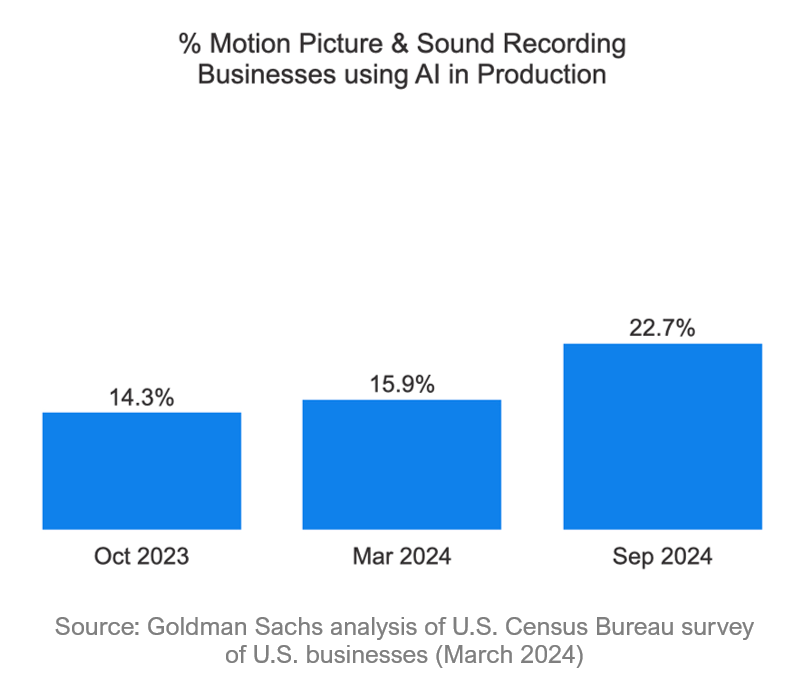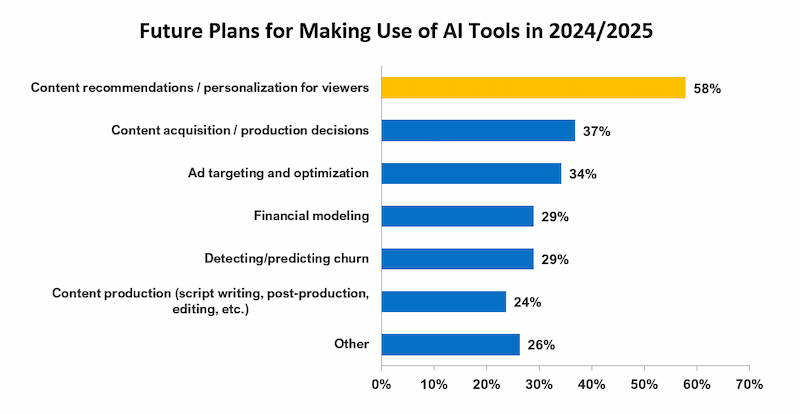Artificial Intelligence (AI) is powering a new generation of software tools and technologies that is already changing how media companies create and distribute content, manage operations, and make sense of data.
Read on to discover key trends for AI in entertainment and how today’s media companies are already using AI to automate routine tasks, support content creation, and make sense of performance, engagement, and revenue data.
1) AI-powered automation helps media companies improve operational efficiency
Media companies are deploying AI applications to streamline and automate routine operational tasks that have traditionally been accomplished through time-consuming manual processes. AI-powered automation is helping media companies operate more efficiently and allocate human resources towards more strategic and value-generating work.
Examples of AI-driven automation in media and entertainment include:
Automating captioning and subtitle generation
Media companies are using AI-driven applications with natural language processing (NLP) capabilities to automate the process of adding captions or subtitles to television and film video assets.
Captioning and subtitling are really two different instances of artificial intelligence in entertainment using similar technology. Subtitling involves translating the spoken narrative or dialogue in a video and displaying it as text in the viewer’s native language, while captioning describes all of the audio information from a video asset (e.g. sound effects, background noise, etc.) in text format so it can be understood and enjoyed by viewers with hearing impairment.
Technology vendors like AI Media, Captions.ai, and Veed.io offer AI-based products that media companies can use to auto-generate captions and subtitles for their video assets.
Automating data normalization
Media companies distributing video assets on traditional linear or streaming platforms receive data in a variety of non-standard formats. This data must be aggregated and normalized before it can be effectively analyzed to extract content performance and revenue insights.
Manually aggregating and normalizing this data becomes increasingly time-consuming and costly at scale, but it’s now possible for media companies to streamline data aggregation and normalization with help from AI-powered tools like Revedia.
Automating metadata generation for media assets
Accurate and detailed video metadata helps media companies catalog assets more precisely, enhances video asset searchability on OTT streaming platforms, and improves content recommendation systems.
AI-driven metadata generation tools use machine learning and computer vision techniques to analyze television and film assets, identifying everything from character/actor appearances and scene descriptions to emotional tone, epilepsy triggers, and explicit content.
Some of the world’s largest technology vendors are already providing AI metadata generation tools for the media and entertainment business. Examples today include Microsoft’s Azure AI Video Indexer, IBM’s Video Streaming tool (powered by Watson AI) and Google Cloud Video AI.
Streamlining analytics workflows with an AI copilot
For media companies with modern analytics tools, data-driven insights are often inaccessible to business users without data analytics expertise. Business leaders end up relying on data analysts and IT to extract the insights they need from the relevant data.
But there’s a new type of AI technology that’s making it easier for users to extract insights from their data: AI copilots.
SymphonyAI’s new Media Copilot allows users to query data by asking questions through a chat-based interface fully integrated into the Revedia software application. As a result, business users can easily get insights from their data without help from IT or DataOps teams.
2) Generative AI helps media companies create new content
Companies are now strategically deploying generative AI in entertainment throughout their content ideation, creation, and production processes. Human writers and content creators are harnessing the power of generative AI to craft compelling narratives, visuals, and musical scores as part of the TV/film production process.
Examples of gen AI in film production include:
AI-generated plot suggestions
Writers in the TV and film industries are using generative AI chatbots to support content ideation and creation activities, including generating plot ideas and helping with screenwriting. ChatGPT works well for this, as its training data set includes many television and film plot summaries.
However, the 2023 Minimum Basic Agreement between the WGA and media companies mandates that AI can’t write literary material (generative AI is not considered a writer, but a tool for writers), AI-generated material can’t be used to undermine a writer’s credit, and that writers can choose to use AI when performing writing services.
AI-driven music composition
In the past, movie producers had to choose between licensing music for film or hiring a composer and musicians to produce an original score. But now there’s a third option: AI-driven music composition.

Media companies are increasingly using AI in sound recording and video production.
AI music generation uses algorithms to generate novel music tracks based on the patterns, structures, and styles of music from the training data set. Examples include:
- AIVA, the AI Music Generation Assistant, that can generate songs in 250+ different styles.
- MuseNet, a deep neural network from OpenAI that generates 4-minute musical compositions with 10 different instruments.
AI-based character animation
AI-based character animation uses predictive algorithms to generate visuals faster and more efficiently than human animators using with costly methods like stop motion animation or CGI. AI-based animation technologies can generate animations from a variety of data sources, including motion capture, 2D drawings, 3D models, and even text-based prompts or scripts.
There are more than 20 technology vendors offering AI-based animation tools for the film industry. Notable examples include:
- Wonder Studio, an AI tool that automatically animates characters into a live-action scene.
- Krikey AI, a tool for animating 3D talking avatars.
- Runway, an AI-based tool with automated text-to-video, image-to-video, and video-to-video animation capabilities.
- Autodesk Maya, an animation, modeling, and VFX tool with AI capabilities.
AI-powered video editing
Technology vendors that provide video editing software to the film industry are upgrading their products with Generative AI capabilities that will accelerate video editing and streamline post-production processes.
Adobe Premiere Pro recently announced new gen AI capabilities that will make it easy for video editors to extend video clips with AI-generated content, as well as add or remove objects from any scene or video clip in post-production.
3) AI-driven analytics helps media companies gain insights from data
Media companies are taking advantage of modern AI-driven analytics tools that make it faster and easier to extract insights from data. Faster insights from content performance, engagement, and revenue data empowers content sellers to make data-driven decisions that help optimize engagement and maximize distribution revenue.
Use cases for AI-driven analytics in media and entertainment include:
Forecasting distribution revenue and predicting content trends
Modern AI-driven analytics tools can use predictive algorithms to forecast future content distribution revenue based on previous results and trends. This can give content sellers the ability to:
- Model different content distribution scenarios to determine which one is most likely to deliver the most revenue.
- Anticipate and effectively manage cash flow to meet short/long-term financial obligations.
- Strategically expand content distribution partnerships with platforms that provide the best revenue outcomes.
- Use variance analysis to better understand factors that impact revenue.
Optimizing content personalization algorithms
OTT streaming service providers are developing AI-based content personalization tools that use predictive algorithms to connect viewers with TV and film content they’re likely to enjoy based on their viewing history.

Media executives are planning to deploy content recommendation and personalization AI tools to support viewer engagement. (Source)
By keeping viewers engaged with desirable content, targeted content recommendations help OTT platforms improve customer satisfaction and mitigate churn.
Analyzing distribution agreements
Media companies can deploy AI-powered applications to automate the process of managing and analyzing content licensing agreements. This includes use cases like:
- Centralizing agreement terms in a single database with analytical capabilities.
- Making agreements searchable to accelerate look-ups and enhance visibility of agreement terms, contacts, clauses, and other information.
- Mapping agreements to distributor payments and other data points.
- Using automated analysis to assess distributor compliance with licensing terms, detect revenue leakage, and identify other anomalies by comparing agreement terms with revenue.
- Using software-based event tracking and notifications to track renewals, expirations, and audit dates.
Check out our Revedia Digital for FAST Agreement Management video to learn more about managing and analyzing content licensing agreements.
Revolutionize your media and entertainment business with SymphonyAI
As the global enterprise AI leader, SymphonyAI is at the forefront of applying powerful generative and predictive artificial intelligence in entertainment.
With SymphonyAI’s Revedia software, media companies can:
- Automate routine tasks from data aggregation and normalization to license agreement management, revenue attribution, and financial reporting.
- Analyze content distribution platform data to understand and make predictions about content performance, engagement, and revenue.
- Harness the power of generative and predictive AI to easily ask questions and engage with data via integrated AI Copilot capabilities.
Ready to learn more?
Watch our on-demand webinar How AI Can Accelerate FAST to learn more about analyzing, predicting, and optimizing content performance with Revedia Digital.
